
Eucalyptus scoparia, commonly known as the Wallangarra white gum or willow gum, is a small to medium-sized tree that is endemic to a small area of eastern Australia. It has smooth bark, linear to lance-shaped or curved adult leaves, flower buds in groups of seven, white flowers and cup-shaped, hemispherical or bell-shaped fruit. It is restricted to a few rocky mountains near the border between New South Wales and Queensland but is widely cultivated.
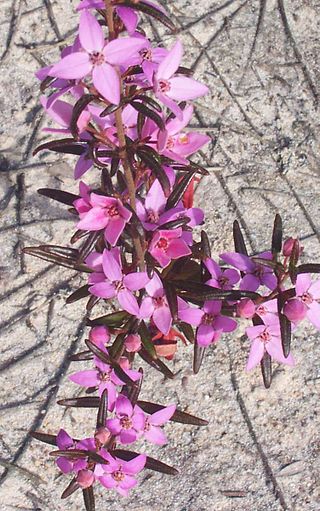
Boronia ledifolia, commonly known as the Sydney boronia, showy boronia or ledum boronia, is a plant in the citrus family Rutaceae and is endemic to south-eastern Australia. It is a shrub with simple or pinnate leaves which have a strong odour when crushed, and pale to bright pink flowers. Although difficult to propagate, this boronia is a popular garden plant.
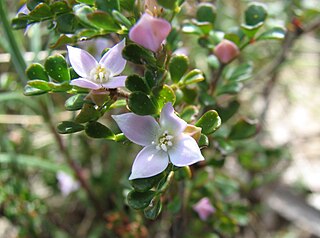
Boronia algida, commonly known as alpine boronia, is a flowering plant in the citrus family, Rutaceae and is endemic to south-eastern Australia. It is an erect shrub with many branches, pinnate leaves and white to bright pink, four-petalled flowers usually borne singly on the ends of branches.

Boronia boliviensis, commonly known as Bolivia Hill boronia is a plant in the citrus family, Rutaceae and is endemic to a small area on the Northern Tablelands of New South Wales. It is a strongly scented shrub with pinnate leaves, deep pink flowers in spring and with its young branches covered with fine, yellow hairs. It is only known from higher parts of the Bolivia Range where it grows on granite outcrops.

Boronia deanei, commonly known as Deane's boronia, is a plant in the citrus family Rutaceae and is endemic to the central and southern highlands of New South Wales. It is an erect shrub with crowded, strongly aromatic leaves and white to bright pink flowers in late winter and spring.

Boronia microphylla, commonly known as small-leaved boronia, is a plant in the citrus family Rutaceae and is endemic to eastern Australia. It is a shrub with pinnate leaves with small leaflets and pink, four-petalled flowers.

Boronia amabilis, commonly known as Wyberba boronia, is a plant in the citrus family, Rutaceae and is endemic to a small area in southern Queensland. It is an erect shrub with many branches, pinnate leaves with hairy lower surfaces and pink, four-petalled flowers.
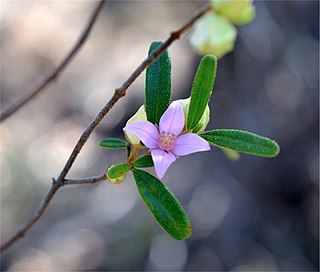
Boronia duiganiae is a plant in the citrus family Rutaceae and is endemic to mountain ranges in south-east Queensland, Australia. It is an erect shrub with many branches, leaves with one, three or five leaflets, and pink to white, four-petalled flowers.

Boronia glabra, commonly known as sandstone boronia, is a plant in the citrus family Rutaceae and is endemic to eastern Australia. It is an erect or weak shrub with many branches, mostly glabrous leaves with a slightly paler underside, and bright pink, four-petalled flowers arranged singly in leaf axils.

Boronia granitica, commonly known as granite boronia, is a plant in the citrus family, Rutaceae and is endemic to a small area of eastern Australia. It is an erect shrub with many branches, compound leaves and pink, four-petalled flowers.
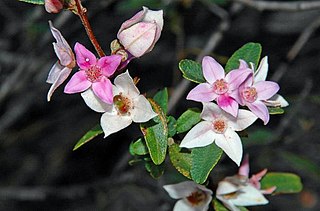
Boronia grimshawii is a plant in the citrus family Rutaceae and is endemic to mountain ranges in central Queensland, Australia. It is an erect shrub with many branches, simple leaves with a densely hairy, pale underside, and pink, four-petalled flowers.
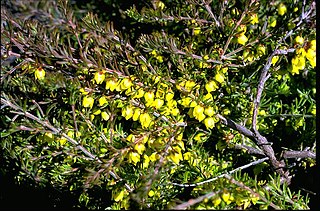
Boronia purdieana is a plant in the citrus family, Rutaceae and is endemic to the south-west of Western Australia. It is a shrub with pinnate leaves and yellow, four-petalled flowers arranged singly in leaf axils.

Boronia rosmarinifolia, commonly known as the forest rose, is a plant in the citrus family Rutaceae and is endemic to eastern Australia. It is a shrub with many branches, simple leaves and pale to bright pink flowers arranged singly in leaf axils.
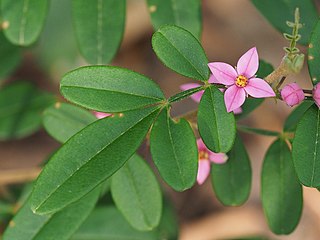
Boronia umbellata, commonly known as the Orara boronia, is a plant in the citrus family Rutaceae and is endemic to a small area on the north coast of New South Wales. It is an erect shrub with many branches, aromatic, pinnate leaves and clusters of up to ten dark pink flowers in the leaf axils.

Boronia adamsiana, commonly known as Barbalin boronia, is a plant in the citrus family, Rutaceae and is endemic to a small area in the south-west of Western Australia. It is an erect, hairy shrub with trifoliate leaves and pink or white, four-petalled flowers.

Boronia beeronensis is a plant in the citrus family Rutaceae and is endemic to the Beeron National Park in Queensland, Australia. It is an erect shrub with many hairy branches, narrow, simple leaves, and four-petalled flowers.

Boronia bella is a plant in the citrus family Rutaceae and is endemic to a mountain range near Many Peaks Queensland, Australia. It is an erect shrub with many branches, simple leaves and four-petalled flowers.
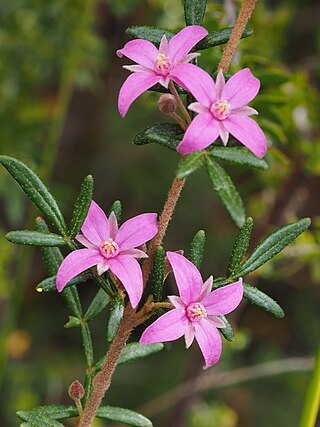
Cyanothamnus inflexus is a plant in the citrus family Rutaceae and is endemic to tablelands near the New South Wales - Queensland border in Australia. It is an erect, woody shrub with pinnate leaves and up to seven white to pink four-petalled flowers in the leaf axils. Boronia bipinnata is similar but has larger, bipinnate or tripinnate leaves and smaller sepals and petals.

Boronia jensziae, commonly known as Andy Jensz's boronia or Hinchinbrook boronia, is a plant in the citrus family Rutaceae and is endemic to Hinchinbrook Island in Queensland. It is an erect, densely branched shrub with simple leaves and pink to white, four-petalled flowers usually arranged singly in leaf axils.
Cyanothamnus montimulliganensis is a plant in the citrus family Rutaceae and is endemic to a single mountain in Queensland. It is an erect, woody shrub with pinnate or bipinnate leaves and white, four-petalled flowers usually arranged singly in leaf axils.





















